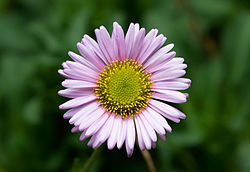| Astereae | |
|---|---|
 | |
| Erigeron glaucus | |
| Scientific classification | |
| Kingdom: | Plantae |
| Clade: | Tracheophytes |
| Clade: | Angiosperms |
| Clade: | Eudicots |
| Clade: | Asterids |
| Order: | Asterales |
| Family: | Asteraceae |
| Subfamily: | Asteroideae |
| Tribe: | Astereae Cass. |
| Genera | |
| Synonyms [1] | |
| |
Astereae is a tribe of plants in the family Asteraceae that includes annuals, biennials, perennials, subshrubs, shrubs, and trees. They are found primarily in temperate regions of the world. [2] Plants within the tribe are present nearly worldwide divided into over 250 genera and more than 3,100 species, making it the second-largest tribe in the family behind Senecioneae. [1]
Contents
The taxonomy of the tribe Astereae has been dramatically changed after both morphologic and molecular evidence suggested that large genera such as Aster , as well as many others, needed to be separated into several genera or shifted to better reflect the plants' relationships. A paper by R. D. Noyes and L. H. Rieseberg [3] showed that most of the genera within the tribe in North America actually belong to a single clade, meaning they have a common ancestor. This is referred to as the North American clade. Guy L. Nesom and Harold E. Robinson have been involved in the recent work and are continuing to re-categorise the genera within the tribe worldwide. [2]






